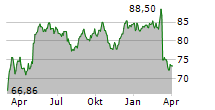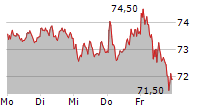NORTHAMPTON, MA / ACCESS Newswire / June 26, 2025 / How Henkel wants to achieve net-zero by 2045
Achieving net-zero by 2045 - that is the target we have set ourselves at Henkel. This presents both numerous opportunities and challenges. And above all, it means a lot of work along the entire value chain of the company. In an interview with Fritz for Future, Henkel's Sustainability Podcast, Dirk Ullrich, Climate and Nature Expert at Henkel, discusses how the net-zero target is integrated into Henkel's sustainability strategy. He explains what net zero really means - and how economic success can be aligned with climate protection.
In this interview, you will learn:
What net-zero means
What the key points of Henkel's net-zero plan are
How Henkel's sustainability strategy has become more ambitious as a result of the net-zero target
In which scope Henkel generates the most emissions
What measures Henkel takes to achieve the net-zero target
Why economic efficiency and climate protection go hand in hand
Why the company's internationality is beneficial for the implementation of the net-zero strategy
Dirk, what does net-zero mean?
Net-zero is about ensuring that the actions of individuals and companies have no impact on the climate. In essence, the term net-zero describes the idea of offsetting the gross activity one carries out with something that removes the resulting emissions from the equation. The fundamental idea behind it is to cause fewer emissions and to offset the remaining ones. To achieve this, emission strategies must be changed. It's not enough to simply try to compensate for emissions. Pure compensation does not change actual behavior, and offsetting measures quickly reach their limits. Net-zero requires strict rules and is too weak a concept on its own if it only focuses on compensation.
I am firmly convinced that climate protection can be achieved using economic means available in today's global economy.
Dirk Ullrich, Climate and Nature Expert at Henkel
What are the key points of Henkel's net-zero plan?
For our net-zero plan, we have not set our own net-zero target or defined for ourselves what that might mean. We follow the Science Based Targets initiative (SBTi), an association of scientists who validate targets. This means that the SBTi reviews and verifies whether the plan we are pursuing aligns with more ambitious net-zero rules. In essence, this means that we must reduce about 90 percent of our emissions and ultimately only offset the remaining 10 percent, also referred to as residual emissions.
To what extent has Henkel's strategy become more ambitious as a result of the net-zero targets?
What makes our current approach significantly more ambitious than our previous goals is that, in addition to our short-term targets oriented toward 2030, we are now also pursuing a long-term target. In a way, we are giving the company a North Star for climate action. A lot will happen by 2045 - many legislative periods will come and go - but it is the ultimate goal that guides our business activities: to achieve climate neutrality for the company across all emission-causing categories - in absolutely all so-called scopes - by 2045. It is comprehensive and long-term.
What exactly are the different emissions scopes - and what do they really mean?
In scope: What do we mean when we talk about scope 1, 2, and 3 emissions?
Insights and examples from a Henkel expert
Learn more
In which scope does Henkel generate the most emissions?
A large portion of our products are consumer goods and therefore most emissions occur relatively far down a very long value chain. Accordingly, our emissions portfolio is structured in such a way that we do not have particularly large amounts of scope 1 or 2 emissions. Our manufacturing processes are relatively efficient and not especially energy-intensive. Therefore, our scope 3 emissions are highly relevant compared to scope 1 and scope 2. When we break down scope 3 emissions, the usage phase of our products is by far the largest source. Significant emission sources are also the procurement of raw materials and packaging materials, as well as a notable share at the end-of-life stage of our products. Transport emissions and all other emissions are relatively low.
What will change at Henkel in the next few years to achieve the newly set net-zero targets?
We have created a so-called Climate Transition Plan. There we have defined key levers to achieve these targets. For our own scope 1 and 2 emissions, we focus on energy efficiency, for example. When we require energy, we use green or climate-neutral sources. Additionally, we generate our own electricity wherever possible, for instance through photovoltaics. Addressing scope 3, we develop products that are significantly lower in emissions during their use. We also use raw materials that are manufactured and produced with significantly fewer emissions. Our logistics and transport needs are also being transformed to cause as few emissions as possible. And the circular economy comes into play wherever we can use recycled materials. Ultimately, the strategy and plan encompass almost all areas of our actions.
It is the ultimate goal that guides our business activities: to achieve climate neutrality for the company across all emission-causing categories - in absolutely all so-called scopes - by 2045. It is comprehensive and long-term.
Dirk Ullrich, Climate and Nature Expert at Henkel
Economic viability and climate protection are often not seen as compatible. What's your perspective, based on your expertise?
I am firmly convinced that climate protection can be achieved using economic means available in today's global economy. Unfortunately, the topic is repeatedly sacrificed in favor of short-term solutions to other problems. I see that as the biggest problem. My answer is: it is possible, and it is also financially manageable. Almost all the technologies we need are available. And we are also seeing positive trends: the costs of battery storage and photovoltaics are going down. Renewable energy sources are surpassing fossil fuels. There are encouraging signs, but there is still a recurring tendency to neglect long-term goals in favor of short-term thinking.
Is it easier or harder to pursue a net-zero strategy when operating globally?
From my point of view, it's easier. We have the invaluable advantage of being able to easily change our perspectives. I talk daily with colleagues from other countries where climate and environmental protection are not central issues. We can learn a lot from each other. I also speak frequently with teams working in regions where climate change has already left its mark and consequences, for example. We have diverse customer and partner relationships in various countries, which also offer a wide range of perspectives. We see different technology opportunities in different parts of the world. And we observe varying approaches to the topic. However, this also means that we need to develop a strategy that works across many countries - at our numerous production sites and locations - and that also covers a vast portfolio of products. But this also presents opportunities and potential, as we have a great lever with far-reaching impact.
Find the full interview (German only) with Dirk on Fritz for Future, Henkel's Sustainability Podcast.

View additional multimedia and more ESG storytelling from Henkel on 3blmedia.com.
Contact Info:
Spokesperson: Henkel
Website: https://www.3blmedia.com/profiles/henkel
Email: info@3blmedia.com
SOURCE: Henkel
View the original press release on ACCESS Newswire:
https://www.accessnewswire.com/newsroom/en/industrial-and-manufacturing/on-the-way-to-zero-1043338



